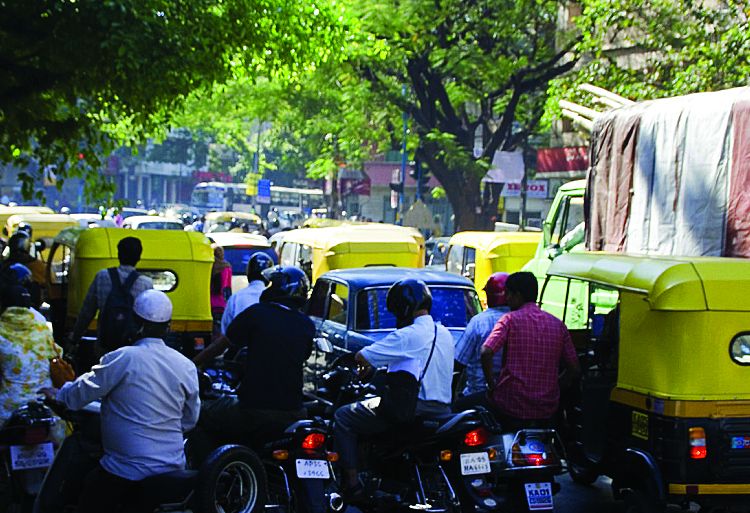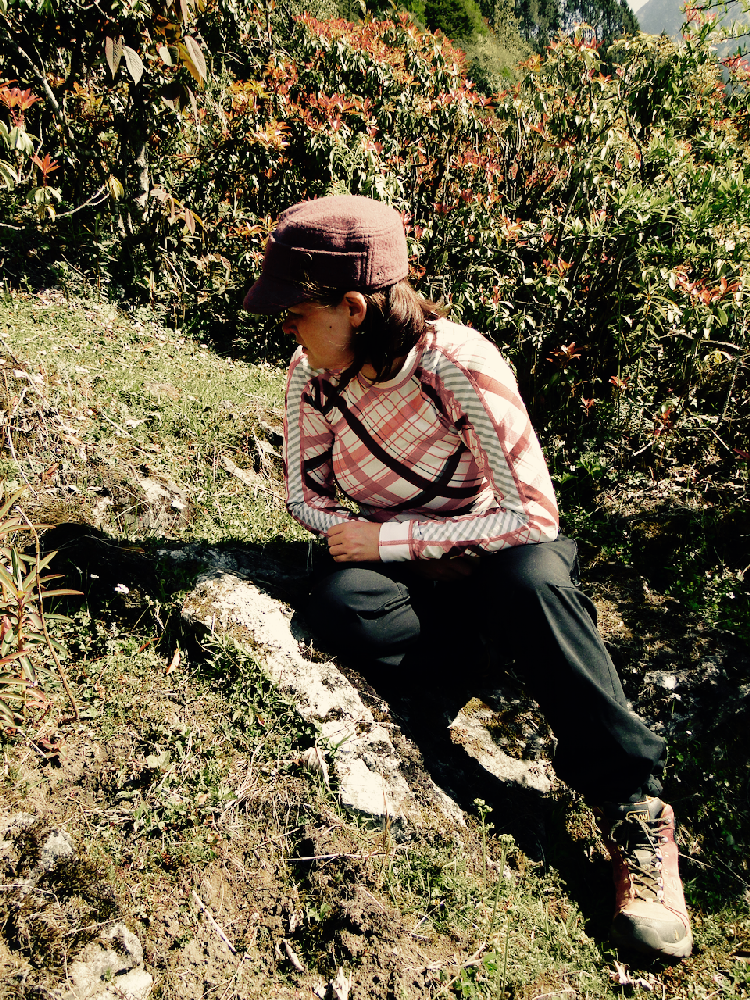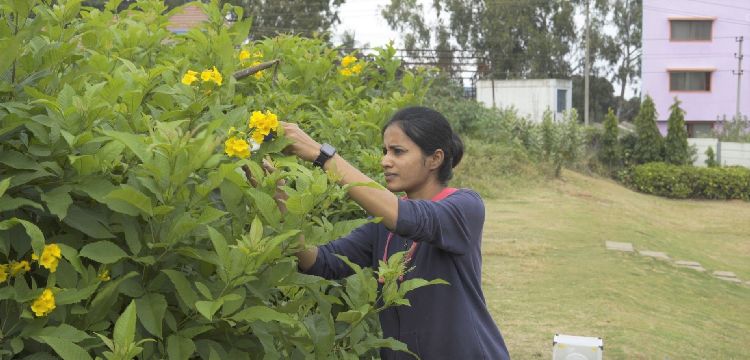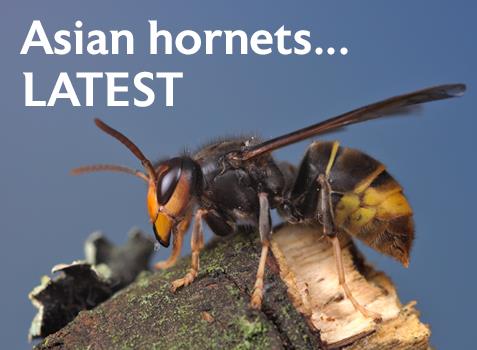 Ranked as the 39th most air-polluted city in the world,* the effects of poor air quality on the 13 million residents of Bangalore (Bengaluru), India’s third largest city, are harsh. They are often startled when they wipe their faces and realise the amount of dust and pollution that has accumulated on their skin. How does this affect bees? By Stephen Fleming, co-editor
Ranked as the 39th most air-polluted city in the world,* the effects of poor air quality on the 13 million residents of Bangalore (Bengaluru), India’s third largest city, are harsh. They are often startled when they wipe their faces and realise the amount of dust and pollution that has accumulated on their skin. How does this affect bees? By Stephen Fleming, co-editor
Researchers at the Indian National Centre for Biological Sciences (NCBS) in Bangalore began questioning the impact the pollution might have on the native, giant honey bee, Apis dorsata. The bee is very important to pollination and therefore the food security of India, the largest food producer and second most populous country in the world. Noticing that there were more species and higher numbers of pollinators outside the city, the researchers thought that the only obvious difference seemed to be pollution. In what way might the pollution be affecting honey bees, other pollinators and insects?
“It was a very emotional experience to see an insect body covered with the pollution under a microscope in our preliminary study,” says Shannon Olsson, a researcher at NCBS. “It was the first time in my research that I cried seeing the results. We didn’t have funding for the research at the time, but this spurred us on.”
A three-year research study, a collaboration between Indian and American researchers and funded by the Tata Foundation, began in 2018.
The context
The research focused primarily on A. dorsata, partly because of its large size and the relative ease with which it can be caught and studied. Although it is known as the rock bee because of its propensity to nest in cliffs, city buildings have also provided suitable nesting sites.
_Rison_Thumboor_CC_2.0_CMYK.jpg) A. dorsata is also important to study because of its migratory habits and the fact that it is not a managed bee – it is not suited to living in boxes. Therefore, the bees currently found in urban areas may not always be urban dwellers; they are quite likely to move to rural areas where pollination is so important and, when they do, the effects of pollution on their bodies and their colonies will move with them.
A. dorsata is also important to study because of its migratory habits and the fact that it is not a managed bee – it is not suited to living in boxes. Therefore, the bees currently found in urban areas may not always be urban dwellers; they are quite likely to move to rural areas where pollination is so important and, when they do, the effects of pollution on their bodies and their colonies will move with them.
Bangalore is still known as a garden city, but its population has soared since 1980, when there were only about three million residents. The IT boom of the 1980s initiated the expansion and, with it, increasing levels of pollution. Now with a population of some 13 million, the forage in Bangalore has declined, but a particular non-native ornamental tree common throughout India, Tecoma stans (yellow bells or trumpet flower), is a favourite foraging tree of A. dorsata. Flowering almost all year around, it is a rich source of nectar and pollen for the bee and provides convenient sample collection points.
The researchers were able to collect 1,820 A. dorsata foraging on Tecoma stans at four different locations that had varying levels of air pollution – a rural location just north of the city plus low, moderate and highly polluted areas within the city.
The damage
 The four sites demonstrated a clear pollution gradient, but even moderate levels of pollution (as measured by respirable suspended particulate matter – RSPM) had an effect on the bees. Damage could be observed physically in electron microscopy images of body parts, functionally through measurable behaviour and physiology, and genetically through gene expression.
The four sites demonstrated a clear pollution gradient, but even moderate levels of pollution (as measured by respirable suspended particulate matter – RSPM) had an effect on the bees. Damage could be observed physically in electron microscopy images of body parts, functionally through measurable behaviour and physiology, and genetically through gene expression.
The visual damage was the most obvious, dramatic and shocking. The chemicals the researchers found on the bees were alarming too. They included arsenic, lead, tungsten and aluminium, and others known to be harmful to animals.
Although the weight of the bee did not seem to be affected, the effect on the body parts was clear (see photos right). Wings, antennae and hindlegs, all vital to the bee’s well-being, were visibly damaged. These differences were not due to the age of the bee – the bees didn’t live long enough for their age to matter. “Bees brought into a ‘good’ laboratory situation are dying within 24 hours,” says Shannon.
The levels of pollution were also negatively associated with how long the bees lived, how often they visited flowers, their heart rate and their respiration rate. Genetically, the bees sampled in the highly polluted areas showed differences too.
Genes linked to stress, nutrition, immunity, defence and other behavioural traits were among those showing different gene expression. Since many other variables apart from pollution levels could conceivably have helped explain such differences, the researchers extended their study to fruit flies (Drosophilia) by exposing them to similar air pollution in the laboratory. Taking all the findings together, the researchers concluded that the RSPM pollution levels were the cause of many of the differences observed in A. dorsata.
Future research?

 The researchers are eager to do more but, alarmingly, Shannon says that attracting funding to the topic is difficult. She is grateful for the support of one of India’s largest philanthropic bodies, the Tata Foundation, but is very disappointed in other reactions: “The food industry does not quite realise how much this matters to their business, and the general public is not aware of how essential pollination is to India’s food security and the health of our ecosystems.”
The researchers are eager to do more but, alarmingly, Shannon says that attracting funding to the topic is difficult. She is grateful for the support of one of India’s largest philanthropic bodies, the Tata Foundation, but is very disappointed in other reactions: “The food industry does not quite realise how much this matters to their business, and the general public is not aware of how essential pollination is to India’s food security and the health of our ecosystems.”
Shannon and Geetha have clear ideas on future research. They want to create pollution in the lab to identify the most damaging pollutants and pesticides through controlled exposure experiments. To try to counteract the funding apathy, they put considerable effort into clear expositions of their research so that it can be understood by the nonscientists, an initiative that has not always sat well with some in the academic community.
REFERENCE
Thimmegowda, Geetha G, Mullen, Susan, Sottilare, Katie, Sharma, Ankit, Mohanta, Saptashi Soham, Brockmann, Axel, Dhandapany, Perundurai S, and Olsson, Shannon B (2020). A field-based quantitative analysis of sublethal effects of air pollution on pollinators, PNAS August 25, 2020 117 (34) 20653-20661 https://doi.org/10.1073/pnas.2009074117 1
* https://www.numbeo.com/pollution/rankings.jsp
May, 2021
Other articles this month included:
Nest-site scouts by Professor Thomas D Seeley
To tang or not to tang by Lucy Frost, Dorian Pritchard and Colin David
Importation of honey bees by Jo Widdicombe



